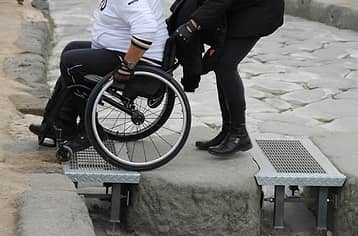- Home
- Accessibility at Pompeii and Herculaneum: Guide for visitors with disabilities
Accessibility at Pompeii and Herculaneum: Guide for visitors with disabilities





Officials at the archaeological park of Pompeii have been working for some years to improve accessibility and make visiting easier and more satisfying for visitors with disabilities. The Pompeii ruins are a UNESCO World Heritage archaeological site and one of the most well-known tourist attractions in Italy, yet visiting Pompeii hasn’t always been easy for disabled visitors. The new accessibility accommodations include information panels in Braille, accessible tours using sign language, as well as an entire wheelchair-friendly itinerary. Accessible Pompeii is now a reality for disabled people including wheelchair users, making a tour of Pompeii possible for visitors to this part of Italy.
To a lesser extent, the Herculaneum archaeological site also offers accessible routes and various arrangements for visitors with disabilities.
Tickets for Pompeii and Herculaneum
Ticket office and free access
Ticket office and free access
First of all, it’s important to know that people with disabilities do not pay entrance fees at Pompeii and Herculaneum.
The ticket office also provides free access for a companion. Anyone with a certified disability can skip the line at the main entrance.
The same concessions are offered by ticket offices for other cultural sites in Campania, including with the National Archaeological Museum in Naples, where many important artifacts including found at Pompeii, including spectacularly preserved mosaic pavements, are now housed and on display.
Wheelchair users
Wheelchair users
Since 2016, the Pompeii archaeological park has offered its “Pompeii for All” accessible path, a wheelchair-friendly itinerary without architectural barriers. This accessible route is just over two miles long and makes visiting Pompeii easier for people with limited mobility.
“Pompeii for All” crosses the ancient Roman city from one side to the other and touches the most important sites of the Pompeii excavations, allowing for a satisfying and comfortable experience for everyone. The presence of accessible platforms and ramps allow visitors with limited mobility, including wheelchair users, to avoid the difficulties of traversing the archaeological site’s uneven and rough surfaces.
To access the “Pompeii for All” route, (called “Pompei per Tutti” in Italian) visitors enter at the Piazza Anfiteatro entrance and exit from Piazza Esedra using the Antiquarium elevator.
The itinerary explores the main streets of the ancient city and allows entry into the most significant domus sites and buildings. The “Pompeii for All” accessible route also allows for a visit to the Forum, which is the scenic heart of the archaeological area.
This special itinerary is ideal not only for people with limited mobility but is also convenient for parents with strollers, elderly visitors, and any visitors who prefer an easier itinerary that nonetheless provides a complete visit.
Practical information for wheelchair users
Even though the special “Pompeii for All” route is specifically free of architectural barriers, it’s important for visitors with disabilities to be aware of some factors that may present challenges:
some ramps and sloping sections can exceed an 8% grade;
there are some small surface level variations (less than 5 cm);
some sections of ancient paving are not uniform;
some sidewalks and crossings are missing wheel guards;
the simultaneous passage of two wheelchairs is only possible in some places.
Wheelchair rental in Pompeii
Some foldable wheelchairs are available for rent inside the archaeological park at the Piazza Esedra and Piazza Anfiteatro entrances.
Reservations are recommended; to book a wheelchair rental email pompei.info@cultura.gov.it or call +39 081 8575 347.
An ID is required to rent a wheelchair.
Visitors who are blind or visually impaired
Visitors who are blind or visually impaired
The Pompeii archaeological site has worked in recent years to improve accessibility for people who are blind and visually impaired. Some areas of the Pompeii excavations offer Braille and tactile 3D models.
Braille support is offered in addition to conventional audio guides and is available, for example, in front of the house of Ceres and in the tannery complex, which is accessible from Via Stabiana.
Visitors who are hearing impaired
Visitors who are hearing impaired
People who are hearing impaired can take part in guided tours of the Pompeii site with specialized native speakers of Italian Sign Language (LIS). Pompeii collaborates with the Naples chapter of the Italian National Agency for the Deaf (ENS) to train guides and improve the accessibility at the site.
People interested in the guided tour with a native-speaking LIS tour guide can request information and organize their visit by sending an email to napoli@ens.it.
Visitors with cognitive and sensory disabilities
Visitors with cognitive and sensory disabilities
To improve inclusion for people with various types of cognitive or sensory disabilities, there are two guides and a map certified "Easy to Read". These were created to accommodate various special needs and use the symbols of Augmentative and Alternative Communication (AAC).
These guides can also be useful to younger visitors and can be downloaded for free from the Pompeii Archaeological Park website (scroll to the "Museum for All" section).
Visiting Herculaneum in a wheelchair
Visiting Herculaneum in a wheelchair
At Herculaneum, people with limited mobility and wheelchair users can use an access ramp at Cardo III. Visitors should first contact the security staff at the main entrance.
Once inside, some wheelchair-accessible routes are available that allow visitors with limited mobility you to explore the main streets that were buried by Vesuvius in 79 AD.
The accessible route includes the cardines and the lower decumanus. A complete map is available on the Herculaneum archaeological park website.
Visitors on the autism spectrum
Visitors on the autism spectrum
Children and adults with autism visiting the Herculaneum can access a dedicated multimedia guide created in collaboration with a non-profit organization that deals specifically with the needs of people with autism.
Interested visitors can make a request to the park by sending an email to the address quellidibluercolano@gmail.com five working days before the day of the visit.